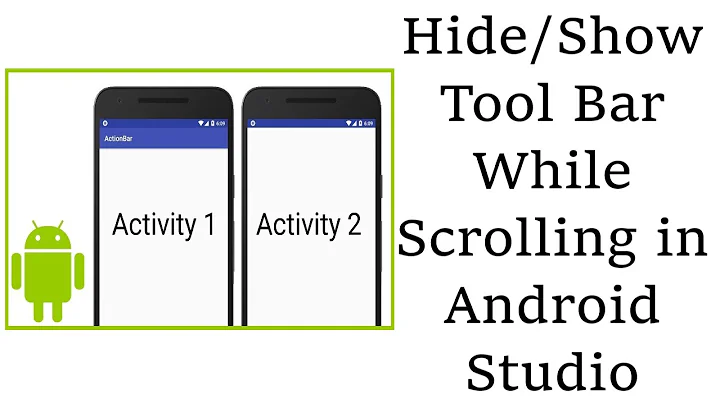Hiding/Showing the toolbar when fragment in the tabs is scrolled
Solution 1
Try this.
main.xml
<android.support.design.widget.CoordinatorLayout
xmlns:android="http://schemas.android.com/apk/res/android"
xmlns:tools="http://schemas.android.com/tools"
xmlns:app="http://schemas.android.com/apk/res-auto"
android:id="@+id/coordinatorLayout"
android:layout_height="match_parent"
android:layout_width="match_parent"
android:fitsSystemWindows="true">
<android.support.design.widget.AppBarLayout
android:id="@+id/appbar"
android:layout_width="match_parent"
android:layout_height="wrap_content"
android:fitsSystemWindows="true">
<android.support.v7.widget.Toolbar
android:id="@+id/toolbarsdfs"
android:layout_width="match_parent"
android:layout_height="?attr/actionBarSize"
android:background="?attr/colorPrimary"
app:layout_scrollFlags="scroll|enterAlways"/>
<android.support.design.widget.TabLayout
android:id="@+id/tabLayout"
android:scrollbars="horizontal"
android:layout_below="@+id/toolbarsdfs"
android:layout_width="match_parent"
android:layout_height="wrap_content"
android:background="?attr/colorPrimary"
app:tabTextColor="@android:color/white"
app:tabSelectedTextColor="@android:color/white"
app:tabIndicatorColor="@android:color/white"
app:tabIndicatorHeight="3dp" />
</android.support.design.widget.AppBarLayout>
<android.support.v4.view.ViewPager
android:id="@+id/pager"
android:layout_width="match_parent"
android:layout_height="fill_parent"
app:layout_behavior="@string/appbar_scrolling_view_behavior"
android:layout_below="@+id/tablayout"/>
</android.support.design.widget.CoordinatorLayout>
fragmentfeeds.xml
<?xml version="1.0" encoding="utf-8"?>
<android.support.v4.widget.NestedScrollView
xmlns:android="http://schemas.android.com/apk/res/android"
xmlns:app="http://schemas.android.com/apk/res-auto"
android:isScrollContainer="false"
android:layout_width="match_parent"
android:layout_height="match_parent"
android:layout_gravity="fill_vertical"
android:clipToPadding="false"
app:layout_behavior="@string/appbar_scrolling_view_behavior">
<LinearLayout
android:layout_width="match_parent"
android:layout_height="match_parent"
android:orientation="vertical">
<ProgressBar
android:id="@+id/progressBar"
style="?android:attr/progressBarStyleSmall"
android:layout_width="wrap_content"
android:layout_height="wrap_content" />
<android.support.v4.widget.SwipeRefreshLayout
xmlns:android="http://schemas.android.com/apk/res/android"
android:id="@+id/swipe"
android:layout_width="match_parent"
android:layout_height="match_parent"
android:background="#FFFFFF">
<WebView
android:id="@+id/webviewtool"
android:layout_width="match_parent"
android:layout_height="fill_parent"
android:numColumns="1"
android:focusableInTouchMode="false"
android:focusable="false"
android:background="#FFFFFF" />
</android.support.v4.widget.SwipeRefreshLayout>
</LinearLayout>
</android.support.v4.widget.NestedScrollView>
Solution 2
Firstly, You should move your webview into NestedScrollView and set 'android:isScrollContainer' property to 'false' value. https://developer.android.com/reference/android/support/v4/widget/NestedScrollView.html
Secondly, You should move your ViewPager outside the AppBarLayout. So, your main.xml should be like this:
<?xml version="1.0" encoding="utf-8"?>
<android.support.design.widget.CoordinatorLayout
xmlns:android="http://schemas.android.com/apk/res/android"
xmlns:app="http://schemas.android.com/apk/res-auto"
android:id="@+id/main_content"
android:background="#FFF"
android:clickable="true"
android:layout_width="match_parent"
android:layout_height="match_parent">
<android.support.design.widget.AppBarLayout
android:id="@+id/appbar"
android:layout_width="match_parent"
android:layout_height="wrap_content"
android:theme="@style/ThemeOverlay.AppCompat.Dark.ActionBar">
<!-- your app bar stuff here -->
<FrameLayout xmlns:android="http://schemas.android.com/apk/res/android"
android:layout_width="match_parent"
android:layout_height="240dp"
app:layout_scrollFlags="scroll|enterAlways">
<ImageView
android:layout_width="match_parent"
android:layout_height="match_parent"
android:scaleType="fitXY"
android:id="@+id/image_header"/>
<include layout="@layout/header"/>
</FrameLayout>
<android.support.design.widget.TabLayout
android:id="@+id/tabs"
android:background="#FFF"
app:tabTextColor="#a3a3a3"
app:tabSelectedTextColor="#a3a3a3"
app:tabIndicatorColor="#0042ab"
android:layout_width="match_parent"
android:layout_height="wrap_content"
/>
</android.support.design.widget.AppBarLayout>
<android.support.v4.view.ViewPager
android:id="@+id/viewpager"
android:layout_width="match_parent"
android:layout_height="match_parent"
android:visibility="gone"
app:layout_behavior="@string/appbar_scrolling_view_behavior"
android:background="#eaeaea"/>
AppBarLayout childern will hide only if they have flag app:layout_scrollFlags
Read more about implementing support design library here:
https://android-developers.googleblog.com/2015/05/android-design-support-library.html
Solution 3
Have a look at
- How to properly hide&show the actionbar using the new design library API?
- Android-ObservableScrollView
Solution 4
You should move your ViewPager outside the AppBarLayout and add behavior to ViewPager app:layout_behavior="@string/appbar_scrolling_view_behavior"
I wrote a full example! https://github.com/erikcaffrey/AndroidDesignSupportLibrary
I hope it help you!
Solution 5
im sorry about my english.
I'll show you how i've made that for my app (min sdk: 14, target sdk: 22). I dont use fragments, i only have a single webview in my activity, but the handler is the same. The probles is when you make scroll inside a webview, Android doesn't handle that like a scroll event, the webview handles his own events.
First i define the styles.xml in res folder. I use a transparent and overlayed ActionBar, thats better when you want to hide and show that:
res/styles.xml
<resources>
<!-- Base application theme. -->
<style name="AppTheme" parent="@android:style/Theme.Holo">
<!-- Customize your theme here. -->
<item name="android:windowActionBarOverlay">true</item>
<item name="android:actionBarStyle">@style/MyActionBar</item>
</style>
<!-- ACTION BAR STYLES -->
<style name="MyActionBar" parent="@android:style/Widget.Holo.ActionBar">
<item name="android:background">@color/actionbar_background</item>
</style>
</resources>
then at the manifest, i define the styles for the app and the ActionBar in the application section:
<application
android:allowBackup="true"
android:icon="@mipmap/ic_launcher"
android:label="@string/app_name"
android:theme="@style/AppTheme" >
<activity
android:name=".MainActivity"
android:label="@string/app_name" >
<intent-filter>
<action android:name="android.intent.action.MAIN" />
<category android:name="android.intent.category.LAUNCHER" />
</intent-filter>
</activity>
</application>
finally in the MainActivity, you must control the gestures in the webview. You must implements the View.OnTouchListener, and the Handler.Callback. When you touch on the webview, you must compare the start event and the end event:
MainActivity.Java
public class MainActivity extends Activity implements View.OnTouchListener, Handler.Callback {
private float x1,x2,y1,y2; //x1, y1 is the start of the event, x2, y2 is the end.
static final int MIN_DISTANCE = 150; //min distance for a scroll up event
private static final int CLICK_ON_WEBVIEW = 1;
private static final int CLICK_ON_URL = 2;
private static final int UP_ON_WEBVIEW = 3;
private final Handler handler = new Handler(this);
public WebView webView;
private WebViewClient client;
private WebAppInterface webAppInt = new WebAppInterface(this);
@Override
protected void onCreate(Bundle savedInstanceState) {
super.onCreate(savedInstanceState);
setContentView(R.layout.activity_main);
webView = (WebView)findViewById(R.id.myWebView);
webView.setOnTouchListener(this);
client = new WebViewClient();
webView.setWebViewClient(client);
webView.loadDataWithBaseURL("file:///android_asset/", "myweb.html", "text/html", "UTF-8", "");
}
//HERE START THE IMPORTANT PART
@Override
public boolean onTouch(View v, MotionEvent event) {
if (v.getId() == R.id.myWebView && event.getAction() == MotionEvent.ACTION_DOWN){
x1 = event.getX();
y1 = event.getY();
handler.sendEmptyMessageDelayed(CLICK_ON_WEBVIEW, 200);
} else if (v.getId() == R.id.myWebView && event.getAction() == MotionEvent.ACTION_UP){
x2 = event.getX();
y2 = event.getY();
handler.sendEmptyMessageDelayed(UP_ON_WEBVIEW, 200);
}
return false;
}
@Override
public boolean handleMessage(Message msg) {
if (msg.what == CLICK_ON_URL){ //if you clic a link in the webview, thats not a scroll
handler.removeMessages(CLICK_ON_WEBVIEW);
handler.removeMessages(UP_ON_WEBVIEW);
return true;
}
if (msg.what == CLICK_ON_WEBVIEW){
Toast.makeText(this, "WebView clicked", Toast.LENGTH_SHORT).show();
return true;
}
if (msg.what == UP_ON_WEBVIEW){
float deltaX = x2 - x1; //horizontal move distance
float deltaY = y2 - y1; //vertical move distance
if ((Math.abs(deltaX) > MIN_DISTANCE) && (Math.abs(deltaX) > Math.abs(deltaY)))
{
// Left to Right swipe action
if (x2 > x1)
{
Toast.makeText(this, "Left to Right swipe [Next]", Toast.LENGTH_SHORT).show ();
}
// Right to left swipe action
else
{
Toast.makeText(this, "Right to Left swipe [Previous]", Toast.LENGTH_SHORT).show ();
}
}
else if ((Math.abs(deltaY) > MIN_DISTANCE) && (Math.abs(deltaY) > Math.abs(deltaX)))
{
// Top to Bottom swipe action -- i SWOW MY ACTIONBAR ON SCROLLDOWN
if (y2 > y1)
{
getActionBar().show();
Toast.makeText(this, "Top to Bottom swipe [Show Bar]", Toast.LENGTH_SHORT).show ();
}
// Bottom to top swipe action -- I HIDE MY ACTIONBAR ON SCROLLUP
else
{
getActionBar().hide();
Toast.makeText(this, "Bottom to Top swipe [Hide Bar]", Toast.LENGTH_SHORT).show ();
}
}
return true;
}
return false;
}
}
I hope thats helps you.
Related videos on Youtube
Faiyaz
My name is Faiyaz Ansari and i am from India. I am doing Computer science.
Updated on March 29, 2020Comments
-
 Faiyaz about 4 years
Faiyaz about 4 yearsI added the new
Toolbar,TablayoutandViewpagerin my android app. I provided Fragments for my 3 Tabs and its working fine. But the problem is that when i scroll up my Toolbar does not hide. I want that when i scroll my fragment it should hide. And one more thing, i am using Webview in the fragment. My codes are given below.MainActivity.Java
public class MainActivity extends AppCompatActivity { TabLayout tabLayout; @Override protected void onCreate(Bundle savedInstanceState) { super.onCreate(savedInstanceState); setContentView(R.layout.main); setupToolbar(); setupTablayout(); } private void setupToolbar() { // TODO Auto-generated method stub Toolbar toolbar = (Toolbar) findViewById(R.id.toolbarsdfs); if (toolbar != null) { setSupportActionBar(toolbar); getSupportActionBar().setDisplayHomeAsUpEnabled(true);} } private void setupTablayout() { // TODO Auto-generated method stub tabLayout = (TabLayout) findViewById(R.id.tabLayout); tabLayout.setTabGravity(TabLayout.GRAVITY_FILL); tabLayout.addTab(tabLayout.newTab().setText("Tab 1")); tabLayout.addTab(tabLayout.newTab().setText("Tab 2")); final ViewPager viewPager = (ViewPager) findViewById(R.id.pager); final PagerAdapter adapter = new PagerAdapter (getSupportFragmentManager(), tabLayout.getTabCount()); viewPager.setAdapter(adapter); viewPager.addOnPageChangeListener(new TabLayout.TabLayoutOnPageChangeListener(tabLayout)); tabLayout.setOnTabSelectedListener(new TabLayout.OnTabSelectedListener() { @Override public void onTabSelected(TabLayout.Tab tab) { viewPager.setCurrentItem(tab.getPosition()); } @Override public void onTabUnselected(TabLayout.Tab tab) { } @Override public void onTabReselected(TabLayout.Tab tab) { } }); } }main.xml
<android.support.design.widget.CoordinatorLayout xmlns:android="http://schemas.android.com/apk/res/android" xmlns:tools="http://schemas.android.com/tools" xmlns:app="http://schemas.android.com/apk/res-auto" android:id="@+id/coordinatorLayout" android:layout_height="match_parent" android:layout_width="match_parent"> <android.support.design.widget.AppBarLayout android:id="@+id/appbar" android:layout_width="match_parent" android:layout_height="wrap_content" android:theme="@style/ThemeOverlay.AppCompat.Dark.ActionBar"> <android.support.v7.widget.Toolbar android:id="@+id/toolbarsdfs" android:layout_width="match_parent" android:layout_height="wrap_content" android:minHeight="?attr/actionBarSize" android:background="?attr/colorPrimaryDark" android:theme="@style/ThemeOverlay.AppCompat.ActionBar" app:layout_scrollFlags="scroll|enterAlways"/> <android.support.design.widget.TabLayout android:id="@+id/tabLayout" android:scrollbars="horizontal" android:layout_below="@+id/toolbar" android:layout_width="match_parent" android:layout_height="wrap_content" android:background="?attr/colorPrimary" /> <android.support.v4.view.ViewPager android:id="@+id/pager" android:layout_width="match_parent" android:layout_height="fill_parent" android:layout_below="@+id/tablayout"/> </android.support.design.widget.AppBarLayout> </android.support.design.widget.CoordinatorLayout>PagerAdapter.Java
public class PagerAdapter extends FragmentStatePagerAdapter { int mNumOfTabs; public PagerAdapter(FragmentManager fm, int NumOfTabs) { super(fm); this.mNumOfTabs = NumOfTabs; } @Override public Fragment getItem(int position) { switch (position) { case 0: Fragment_Feeds tab1 = new Fragment_Feeds(); return tab1; case 1: Fragment_Facts tab2 = new Fragment_Facts(); return tab2; default: return null; } } @Override public int getCount() { return mNumOfTabs; } }Fragment_Feeds.java
public class Fragment_Feeds extends Fragment { SwipeRefreshLayout swipeView; WebView myWebView; ProgressBar progressBar; final static String myBlogAddr = "http://myblog.com"; String myUrl; @Override public View onCreateView(LayoutInflater inflater, ViewGroup container, Bundle savedInstanceState) { View view = inflater.inflate(R.layout.fragmentfeeds, container, false); swipeView = (SwipeRefreshLayout) view.findViewById(R.id.swipe); myWebView = (WebView) view.findViewById(R.id.webview); progressBar = (ProgressBar) view.findViewById(R.id.progressBar); myWebView.setWebViewClient(new MyWebViewClient()); WebSettings webSettings = myWebView.getSettings(); webSettings.setJavaScriptEnabled(true); myWebView.setOverScrollMode(View.OVER_SCROLL_NEVER); myWebView.setScrollBarStyle(WebView.SCROLLBARS_OUTSIDE_OVERLAY); myWebView.setHorizontalScrollBarEnabled(false); myWebView.loadUrl("http://myblog.com"); swipeView.setOnRefreshListener(new SwipeRefreshLayout.OnRefreshListener() { @Override public void onRefresh() { myWebView.loadUrl("http://myblog.com"); }}); return view; } private class MyWebViewClient extends WebViewClient { @Override public void onPageFinished(WebView view, String url) { swipeView.setRefreshing(false); } @Override public boolean shouldOverrideUrlLoading(WebView view, String url) { myUrl = url; view.loadUrl(url); return true; } @Override public void onReceivedError(WebView view, int errorCod,String description, String failingUrl) { myWebView.loadUrl("file:///android_asset/error_page.html"); } } @Override public void onCreateOptionsMenu(Menu menu, MenuInflater inflater) { inflater.inflate(R.menu.main, menu); super.onCreateOptionsMenu(menu, inflater); } }fragmentfeeds.xml
<LinearLayout xmlns:android="http://schemas.android.com/apk/res/android" android:layout_width="match_parent" android:layout_height="match_parent" android:orientation="vertical" android:background="#FFFFFF" > <ProgressBar android:id="@+id/progressBar" style="?android:attr/progressBarStyleSmall" android:layout_width="wrap_content" android:layout_height="wrap_content" /> <android.support.v4.widget.SwipeRefreshLayout xmlns:android="http://schemas.android.com/apk/res/android" android:id="@+id/swipe" android:layout_width="match_parent" android:layout_height="match_parent" android:background="#FFFFFF">s <WebView android:id="@+id/webview" android:layout_width="match_parent" android:layout_height="fill_parent" android:numColumns="1" android:scrollbars="none" android:focusableInTouchMode="false" android:focusable="false" android:background="#FFFFFF" /> </android.support.v4.widget.SwipeRefreshLayout> </LinearLayout>What i want?
What i want is that when i scroll the webview upwards, the toolbar should also scroll upwards and hides and when i scroll back down the toolbar should come back as soon as possible.
-
 Pankaj Arora over 8 years
Pankaj Arora over 8 years -
 Ashish Dwivedi over 8 yearsAdd app:layout_scrollFlags="scroll|enterAlways" in toolbar
Ashish Dwivedi over 8 yearsAdd app:layout_scrollFlags="scroll|enterAlways" in toolbar -
Vikash Kumar Verma over 7 yearsif you are using gridview in fragment then add android:nestedScrollingEnabled="true" in gridview
-
-
 Faiyaz over 8 yearsI cannot use <include layout="@layout/header> because i am using tablayout.
Faiyaz over 8 yearsI cannot use <include layout="@layout/header> because i am using tablayout. -
Andrew over 8 yearsIt's just an example. I edit your xml gist.github.com/devindi/e46b0206aa84228831b4
-
 Faiyaz over 8 yearsI think you didn't understood my question. Actually i am using fragments for the tab.
Faiyaz over 8 yearsI think you didn't understood my question. Actually i am using fragments for the tab. -
Andrew over 8 yearsI write same app few weeks ago. So I understood you. I has big scrollable header, tab layout and view pager with 3 fragments. Right?
-
 Faiyaz over 8 yearsNo my app don't have big scrollable header. It has a toolbar, Tablayout, and viewpager. And i dont want to hide tablayout on scroll , i just want to hide toolbar on scroll.
Faiyaz over 8 yearsNo my app don't have big scrollable header. It has a toolbar, Tablayout, and viewpager. And i dont want to hide tablayout on scroll , i just want to hide toolbar on scroll. -
 Faiyaz over 8 yearsand yead view pager have 2 fragments.
Faiyaz over 8 yearsand yead view pager have 2 fragments. -
Andrew over 8 yearsSo, you need smth like that dropbox.com/s/1apmu35aie2cp0p/output.gif?dl=0
-
 Faiyaz over 8 yearsYes i want something like that
Faiyaz over 8 yearsYes i want something like that -
 Faiyaz over 8 yearsIf i take the viewpager out of AppBar it fill the whole screen
Faiyaz over 8 yearsIf i take the viewpager out of AppBar it fill the whole screen





![How to show/hide Toolbar when scrolling RecyclerView - [Android Animations - #07]](https://i.ytimg.com/vi/LLWFg7mG0Aw/hq720.jpg?sqp=-oaymwEcCNAFEJQDSFXyq4qpAw4IARUAAIhCGAFwAcABBg==&rs=AOn4CLAGJihtQD_6QNgf89L2W1jmRbECJQ)
